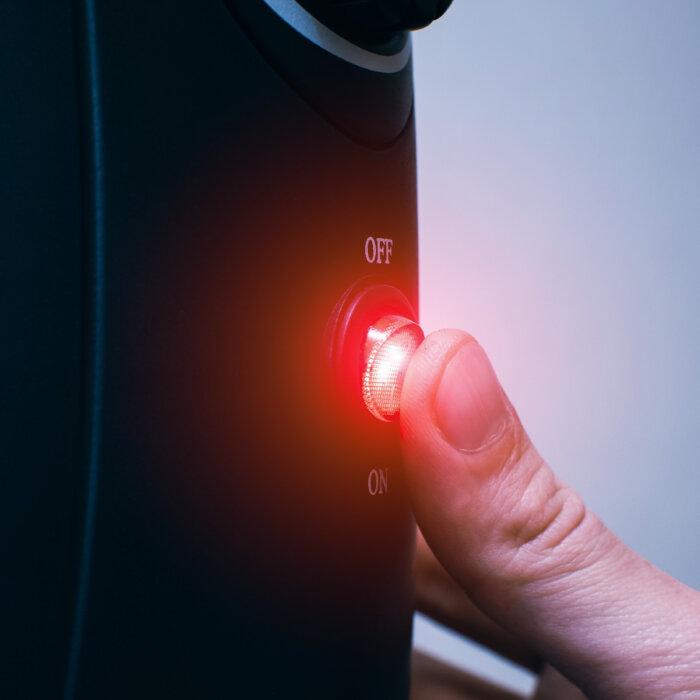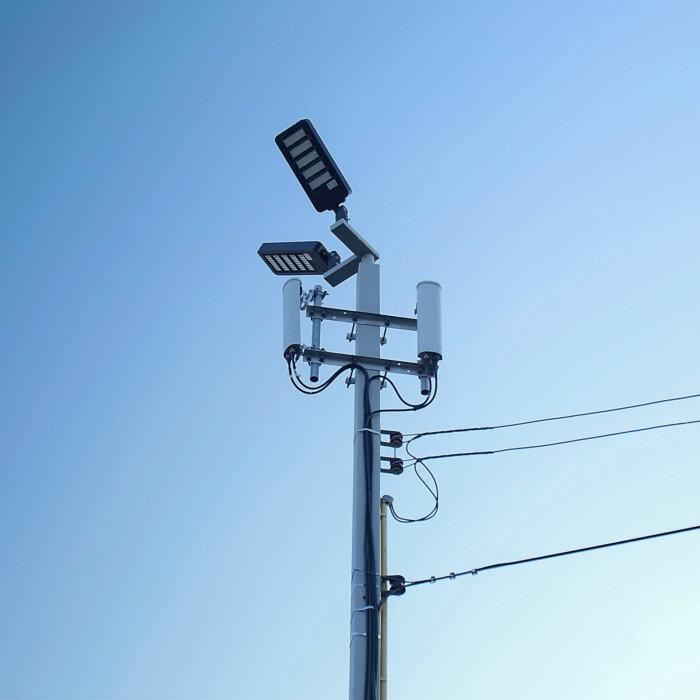Sources of EMFs in the Home
Although the human body emits its own EMFs, it’s also vulnerable and susceptible to certain external EMFs.- Radiofrequency (RF) radiation produced from wireless communication signaling.
- Extremely low-frequency (ELF) radiation produced by electricity.

1. EMFs From Wireless Electronics
Emitted by: mobile phones, Wi-Fi modems, Bluetooth devices, TVs (use radio waves), smartwatches, smart virtual assistants such as Alexa, smart lighting, and all other “smart” electronics
Everything is “smart” now, even many of our wristwatches.Wireless and smart devices connect to mobile networks through radiofrequency radiation. Most radio frequencies have a frequency between 3 kHz (kilohertz) to 300 GHz (gigahertz).
However, not all radio frequencies have the same health impact.
“Typically, the higher the frequency of a signal, the more reduced its ability to penetrate,” James Finn, president, principal electromagnetic interference engineering consultant, and senior consultant for EMFs at Elexana, told The Epoch Times. “A signal at 28 GHz or higher would have difficulties going through a brick façade.”
While 5G, the most recent mobile network, has been advertised as less penetrating because of having a higher frequency than 3G and 4G, Mr. Finn said that this may not entirely be the case.
Ways to Reduce Radiofrequency Exposure
- Opt for hardwiring: Dr. David Carpenter, a professor in environmental health from the University of Albany, suggests the use of ethernet cables and cabled landlines for internet and phone connections, minimizing reliance on wireless signals in the home and reducing radiofrequency exposure.
- Replace Bluetooth earphones: Replace Bluetooth earphones by putting the phone on speaker or using wired earphones to keep radiofrequency radiation away from your head.
- Go ‘unsmart’: Minimize the use of smart devices such as smart thermostats, smart blenders, and smartwatches.
- Take bedtime precautions: Bedtime is when the body rests and heals itself from all the stress it experienced during the day, Professor Emerita Magda Havas from Trent University told The Epoch Times. Consider turning off Wi-Fi modems and putting mobile phones and wireless devices in airplane mode before bed.
- Check for nearby wireless antennas: Ensure that no small cells (base stations) or cell phone towers are installed near your home, as their signals can contribute to higher RF radiation exposure. With the rollout of the 5G network, people increasingly find 5G small cells planted near their homes. In the next article, we will discuss ways to be on the lookout for 5G small-cell installations.
- Use RF meters: RF meters, or radiofrequency meters, can detect the overall intensity of radio frequencies in the home and help to identify sources of intense radiofrequency radiation, allowing for informed mitigation measures.
2. EMFs From Electricity
Emitted by: overhead power lines, home wiring, stray currents, and all electronic appliances
Apart from wireless devices, all home electronics—when in use—can give off extremely low-frequency EMFs, or ELF EMFs. Most electrical appliances in the home have a frequency ranging from 60 Hz to 300 Hz.1. ELF Magnetic Fields
Electricity flows through wires like water flows through pipes. As it flows, the current generates magnetic fields.Take a look at an appliance such as a hair dryer. The plugs should have two metal prongs; these represent two wires paired in a power cord—the “neutral” and “hot” wires. The two wires are in close proximity and carry electric current in opposite directions, canceling the magnetic field emission.
If the power cord is damaged, causing the two wires to separate, or if the wrong neutral and hot wires are paired, the magnetic fields won’t cancel each other out, resulting in intensified magnetic field emissions.
Electrical appliances with motors also tend to produce strong magnetic fields. These can include appliances such as refrigerators, dishwashers, hair dryers, and anything that produces heat or has moving parts that use electric motors.
2. ELF Electric Fields
When a lamp is plugged into a power outlet, an electric field will emanate from the wall outlet down the lamp’s power cord and all the way up to the light bulb. The magnetic field, however, is produced only once the lamp is turned on.Properly grounded devices and appliances with three-pronged cords (the third prong is a ground conductor) will emit smaller electric fields than those with only two prongs.
In the United States, devices with 120 volts or less aren’t required to have a grounding prong, so some manufacturers opt for compact, lightweight, and ungrounded plugs. These products are usually insulated to protect users from live parts. Yet water breaches can cause dangerous shocks.
Mr. Finn, who has more than 30 years of experience working with electromagnetic interference, emphasized the importance of checking for proper grounding and bonding, and verifying that the grounding rod has a resistance below 25 ohms.
The grounding rod links your home’s electrical wiring back to the earth, which allows any problematic current to dissipate in the ground. This rod, planted deeply in the dirt, is connected through a thick copper wire to your home’s electrical panel, which is where electricity comes into your home from the electrical grid.
The lower the resistance of the grounding rod, the easier it is for electricity to pass through it.
“If the ground conductor from the main panel is not properly connected to the ground rod and the ground rod is oxidized, meaning rusted, the grounding system may not be sufficient to shunt electric fields,” Mr. Finn said.
Ways to Reduce ELF Magnetic and Electric Field Exposure
- Inspect your electrical wiring: Hire an electrician to inspect your home’s wiring to see if it’s properly grounded and ensure there are no errors or safety issues.
- Avoid power lines: Live and sleep far away from power lines, as they can produce strong magnetic fields and ground currents.
- Use a gauss meter: A gauss meter is a device that measures magnetic fields to identify areas with higher field strengths.
- Maintain distance: Maintain a 6- to 8-foot distance from larger electronic appliances and devices and electrical equipment when in use to reduce your exposure, Mr. Finn said.
- Replace damaged appliances and use three-pronged corded devices: Replace two-pronged corded electrical devices with three-pronged corded versions, if possible. An electrician may be able to add the ground prong to the power cord, if needed. Consider replacing electronic appliances that have damaged wiring or signs of malfunctions to prevent shock hazards.
- Turn off electricity in the bedroom: In most cases, turning off electricity in the room can reduce EMFs and may be helpful for electrosensitive individuals. However, on rare occasions, this can actually strengthen the electric fields because of the wiring setup in the home. If the room has wires that run adjacent and opposite to each other, turning off the electricity in one wire may intensify the electric field in the other.
- Use voltmeters: Voltmeters can be used to detect electric fields.
3. Electromagnetic Interference
Emitted by: wireless devices, fluorescent and LED lights, light dimmer switches, solar panels, pool pumps, and air conditioners
Electromagnetic interference (EMI), also known as signal-to-noise, line noise, or dirty electricity, can be likened to an unwanted waste product. It’s the hissing sound in radios, the buzzing sound in phone conversations, and the flicker in television receivers.Electricity is transmitted from the power station through power lines to our homes. Inside our homes, electricity flows through the wiring in the walls, which then powers appliances.
The issue arises because power lines carry alternating current (AC) electricity, whereas many electronics use direct current (DC) electricity. When appliances convert AC electricity to DC, signal noise is generated as a byproduct.
This signal noise doesn’t stay confined to a specific area but propagates throughout the home via wiring. Additionally, the noise can also be emitted into the air.
Any device using diodes inevitably produces EMI. Diodes are commonly used in electronics to convert AC to DC.

LED lights are one of the most common light sources that use diodes to produce light. The acronym “LED” stands for light-emitting diode.
Wi-Fi, smart meters, and devices that release radio frequencies can also produce EMI because of the interactions between radiofrequency signals.
Fluorescent lights and variable-speed motors used in pool pumps and air conditioners first convert AC electricity to DC, and then back to AC electricity. Electricity produced by solar panels similarly goes through a series of conversions, creating EMI. Light dimmer switches don’t create signal noise through conversions. Instead, they chop up certain AC waves coming into the lamp, producing noise signals in the output.
Ways to Reduce Electromagnetic Interference Exposure
- Ensure proper grounding: Improper grounding can exacerbate EMI.
- Minimize certain electronic devices: Reduce the use of or replace electronic devices that produce signal noise, such as LED and fluorescent lights, with incandescent lights. Incandescent lights are the closest to natural light because the light is produced from electricity heating a filament.
- Power off devices: Turn off electronic devices and appliances when not in use or while you’re sleeping.
- Consult a certified Building Biology Institute electromagnetic radiation specialist (EMRS): Engage the expertise of an EMRS to identify the primary sources of actionable EMF and EMI in your living or working environment.








